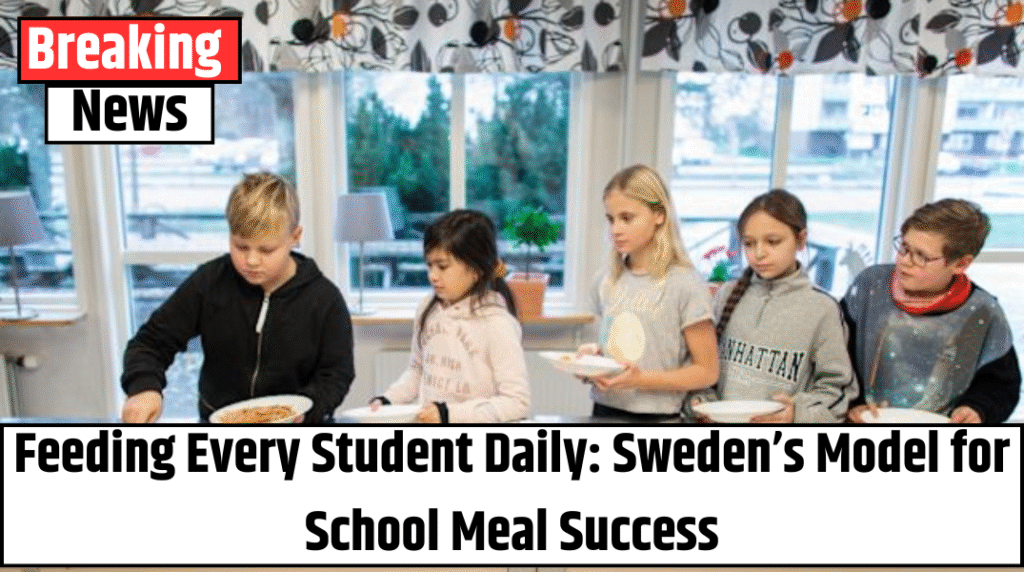The UK government recently took a major step toward tackling child poverty by expanding free school meals to all families receiving Universal Credit. The policy shift is expected to benefit around 500,000 children and potentially lift 100,000 of them out of poverty, saving families about £500 a year.
While the move is being welcomed, some educators and campaigners believe it doesn’t go far enough. The National Education Union, for example, is pushing for universal free school meals across all primary schools in England—similar to what’s already being done in London and Wales. Scotland, too, has adopted the program up to age 10.
But across the North Sea, Sweden has been quietly leading the way for decades. For over 30 years, every student in Swedish schools—up to the age of 16—has received a free, nutritious lunch and snack each day, without exception. This universal model has not only supported children’s health but also improved long-term educational and economic outcomes.
Insights from the Swedish System
Yvonne Andersson, a retired school principal who worked in Sweden’s education system for over 40 years, saw firsthand the transformative power of universal school meals. Based in the town of Veberöd in southern Sweden, Andersson helped manage both preschools and primary schools.
She recalls frequent visits from international educators eager to study Sweden’s approach. “Our system is truly unique,” Andersson says. “Educators from around the world are amazed by how seamless and integrated our school meal program is.”
Sweden’s commitment to feeding its children stretches back to the 19th century, when local programs offered porridge and milk to children living in poverty. The initiative gained traction in the 1930s, and by 1997, the government made it mandatory for all municipalities to offer free meals to students aged 6 to 16.
Also Read – New School Opening Times Announced Across England for Monday
Andersson, who was born in 1946, has been part of this evolution both as a student and educator. “We didn’t think twice about it growing up—it was simply normal to have a free hot lunch at school.”
A Routine That Fosters Equity
In the schools where Andersson worked, the daily routine starts early. Preschoolers and children in after-school care are served breakfast at 7 a.m. Lunch follows at staggered times depending on the age group, beginning at 11 a.m. for the youngest students. Every child has multiple meal options, including vegetarian and special dietary meals for those with medical or religious needs.
Students eat in designated school dining halls, guided by their teachers who also dine alongside them. Teachers are not charged for these meals—they are considered part of the educational environment, where mealtime becomes an opportunity to reinforce social and conversational skills.
Andersson notes that even leftover food is put to good use. “We serve extra portions to local pensioners on fixed incomes,” she says. “It helps reduce waste and supports the broader community.”
Real-World Benefits
The long-term effects of Sweden’s policy are now being quantified. Petter Lundborg, an economics professor at Lund University, has studied the impact of free school meals on child development and life outcomes. His findings are striking.
According to Lundborg, children who received free meals throughout their compulsory schooling were more likely to attend university and enjoyed a modest but meaningful increase in lifetime earnings—about 3% on average. Those from low-income households saw even greater gains, up to 6%.
The research also found that these children grew taller—about 1cm more than their peers without access to the program—highlighting the nutritional benefits. “The greatest impact was seen among children from disadvantaged backgrounds,” Lundborg explains. “But by offering the program universally, the stigma often associated with free meals was eliminated.”
However, not every metric saw improvement. The study found no significant changes in school attendance or health outcomes like sickness or mortality. Body size remained stable, suggesting that while the meals were nutritious, they didn’t lead to overconsumption.
A Cost Shared Locally
Unlike in the UK, where education funding often flows through centralized structures, Sweden’s school meals are financed through local taxation. Municipalities are responsible for setting their own education budgets, which include funds for school food services.
“In Lund, for example, we contribute 21.24 kronor for every 100 kronor we earn,” Andersson says. This revenue is then distributed among schools in proportion to their size and student needs.
Despite the decentralized model, Sweden maintains national standards: meals must be free, nutritious, and available to every student. Andersson emphasizes that this system erases class distinctions. “No one stands out. Rich or poor, every child eats the same. That’s the beauty of it.”
Also Read – South West Schools Join Forces to Fight Education Inequality
Supporting Families and Futures
Andersson believes the universal meal program has ripple effects beyond education. For working parents, especially those in lower-income households, knowing their children are fed and cared for during the school day provides peace of mind and enables them to stay employed.
In some cases, school meals have been a lifeline. Andersson recalls a time she insisted a struggling family enroll their children in after-school care so they could access regular meals. “The kids were hungry. Their mother was unable to provide breakfast. At school, they finally had what they needed: food, structure, and care.”
Could the UK Go Further?
As the UK begins to expand access to free school meals, Sweden’s example offers a compelling case for a universal approach. The data suggests it can reduce inequality, improve educational outcomes, and support families—all without stigma.
And for advocates like Andersson, the argument is simple: “If every child has the right to education, why shouldn’t they also have the right to be nourished while they learn?”



